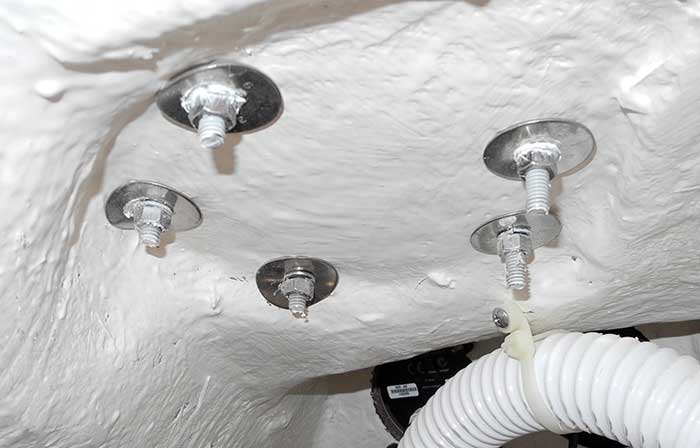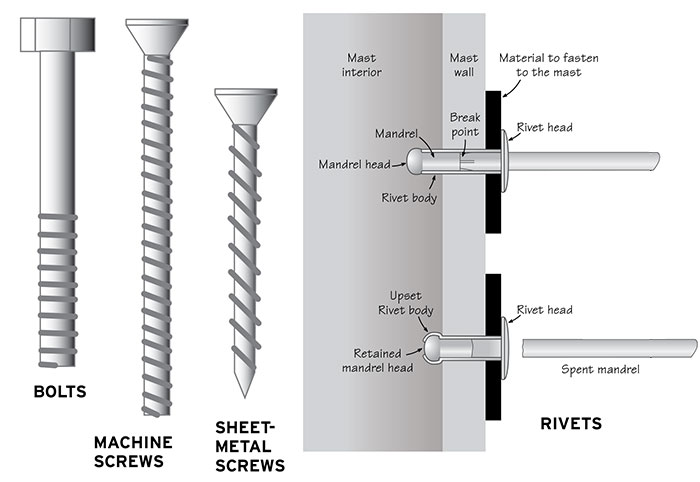Advertisement
First, assess the load this fastener will need to handle. Then choose among very different fasteners for different challenges. Don't worry, Don's here to help you figure it out.

Anything you want to attach to your boat has to be fastened in some way. Today we have astounding glues that are stronger than the materials they bond, and some tapes are capable of joining railroad cars. Most of the time, though, mechanical fastening will be the attachment method of choice. Metal fasteners set the bar for strength, offer unmatched longevity, and most can be disassembled without destruction. Select wisely and install carefully to ensure your fasteners hold to their maximum strength.
Selecting the right fastener (see below) begins by assessing the load that will be placed on it. Any metal fastener will hold well against a sideways (shear) force. But with a tensile force pulling the fastener straight out, holding strength becomes increasingly dependent on the threads (or formed head in the case of rivets) holding the fastener in place. The load on lifting and towing eyes is almost entirely tensile — it is trying to stretch the fasteners or pull them from their holes. When the tide goes out, docklines start to tug upward on cleat fasteners. Pedestal seat bases pry up mightily on their forward fasteners, then on their aft ones as your body weight shifts in a chop.
When Choosing A Metal Fastener, The First Question Is What Type?

Illustration: ©2013 Mirto Art Studio
Here are some options:
- Bolts require nuts and access to both sides of the fastener hole.
- Machine screws are identical to bolts but thread into a tapped hole. Sheet-metal and wood screws are self-tapping, cutting threads into the smooth surface of a drilled hole.
- Rivets have no threads. They come with a factory head on one end, with the other end deformed at installation to create a second "head." The rivets contemporary boat owners are likely to use will be blind rivets, commonly called pop rivets, which can be installed even if you only have access to one side of the fastener hole.
In general, the weak link in the attachment of a fastener is the internal threads that the fastener's external threads engage. Threads cut by wood screws into wood, or by sheet-metal screws into fiberglass, lack the strength, consistency, and durability that machined threads inside a metal nut or other thick metal component can provide. Bolts or machine screws must be used to secure any component or piece of hardware essential to boat function and/or safety that might experience a load that will or could pull or pry it from the boat. In addition to nuts on the backside of the fitting, through-bolt mounting should include a strong backing plate made out of aluminum or stainless steel or, at the very least, heavy fender washers to spread the load.
Besides eyes, cleats, and pedestals, the items that need to be secured with bolts that pass through the deck or hull include handrails, windlasses, and safety rail or lifeline stanchion bases; davits, cranes, and pole mounts; wakeboard towers and ski pylons; and for sailors, winches, travelers, and headsail tracks. Hardware of lesser import or subject to little stress can be fastened with screws. This would include things like deck fills, ventilators, rod holders, flagpole sockets, and running lights.
Advertisement
Wood screws are for wood only, never fiberglass. If you think an underlying wood core alters this, you are doubly wrong. You should never screw any type of fastener into (or through) core material. In all cases, core around the fastener must be removed and replaced with epoxy putty sufficient to isolate the core from the fastener hole. Sealants won't prevent water from reaching and ultimately destroying core. So whether installing screws into solid laminate or through a fiberglass skin into a core plug of cured epoxy, use stainless-steel sheet-metal screws. But sheet-metal screws should never be used to fasten hardware to extruded aluminum spars (masts, booms, spinnaker poles, and so on) because sheet-metal screws are designed to be held in place by a single thread and are not meant to cut threads — they distort the walls of the hole into a helix. Your choice here will be between machine screws and blind rivets.
Blind rivets are the easiest, although you'll need a riveting tool. Blind rivets for marine use can be made out of aluminum, Monel (a nickel/copper alloy), and stainless steel. Aluminum rivets won't cause corrosion due to dissimilar metals, but they are the lowest strength. 316 stainless steel and Monel rivets are more than twice as strong as aluminum and do well in the marine environment, but both require a pre-installation coating of Tef-Gel, a PTFE paste, to reduce the risk of corroding the aluminum. Some aluminum and Monel rivets come with steel mandrels (the post inside the rivet that helps to create the head on the blind side of the hole), and those invariably rust in the marine environment. Aluminum rivets should have aluminum mandrels; Monel rivets should have Monel mandrels.
Mast-hardware brackets often extend around to the sides of the spars so that the forces on the fitting will be shear instead of tensile. Stainless-steel blind rivets are often specified for this type of bracket. Where the loads will be tensile, a stainless-steel machine screw can deliver roughly half again the holding strength of a stainless blind rivet. This assumes a pilot hole drilled to the proper size, internal threads cut carefully with a sharp tap, and a wall thickness sufficient for at least three threads — which is 0.150 for a 1/4-20 screw (20 threads per inch). Note that tensile loads on screws place shear loads on the threads, so in soft material like aluminum, you'll generally get greater holding power with thicker, i.e., coarser, threads. For example, select 1/4-20 rather than 1/4-28 screws for mounting hardware to a mast.
Buying Quality Fasteners
For marine applications, the fastener material of choice, excluding aluminum rivets, will nearly always be stainless steel. Bronze is equally good but only for fastening bronze hardware. Avoid entirely typical hardware store offerings of brass and plated steel.
Where do you get high-quality marine fasteners? Your local boat-supply store should carry a good selection. Many hardware stores also stock stainless fasteners. However, not all stainless steel is created equal. Try to get a look at the box the specific fasteners came in. Retail fasteners labeled "18-8" are nearly always type 304. You will be better off, particularly if your boating waters are salt, using the more corrosion-resistant type 316.
Finding and obtaining 316 fasteners has become infinitely easier with the Internet and fast shipping. Check Jamestown Distributors, a notable source of virtually every type of fastener that any boat owner (or builder) might need. Unfortunately, you may have to buy 100 when you only need four, so also look for a local source, such as West Marine, and check if they have quality type 304 and 316 screws and bolts. Each fastener will cost more, but you'll spend less overall if you don't need the quantity.
Installing Carefully
Wood and sheet-metal screws require pilot holes. There are tables that specify the correct drill size for a particular screw size, but for wood screws an eyeball match of the drill bit to the minor or root diameter (diameter of the screw if the threads were ground away) will be close enough in most circumstances. However, you can't be so cavalier when installing a sheet-metal screw into fiberglass because reinforced laminate will not give like wood. If your pilot hole is even a few thousandths too small, the screw will bind and probably break. Here you need the help of a chart or the accuracy of a caliper, and always err on the side of the pilot hole being slightly oversize rather than undersized. In fiberglass you must also chamfer pilot holes with a countersink bit to prevent the screws from fracturing the brittle gelcoat layer. Countersink all fastener holes to be bedded to enhance the durability of the seal.
Lubricating screw threads with wax, paraffin, or even soap will make driving new screws into wood easier. When driving a self-tapping screw into fiberglass, the usual thread lubricant is a smear of the chosen sealant that will be used to bed the screw. To improve the odds of later being able to unscrew nuts and machine screws threaded into tapped holes in steel, use an anti-seize compound such as those made by Permatex and Bostik.
The downside to using lubricants to install threaded fasteners is that they also make it easier for the fastener to loosen by itself. To prevent a nut or screw from loosening, the split-lock washer, despite its ubiquity, is completely worthless. Toothed lock washers are only marginally better with stainless-steel fasteners. Bolts can be secured with a lock nut of some type, the usual choice being the nylock nut, which has a nylon collar that grips the screw. The only dependable choice for preventing threaded fasteners from vibrating loose is to coat the clean threads with a liquid thread-locking adhesive at assembly. If you use Loctite, the best-known thread locker, always use the blue version (242). Screws assembled with blue Loctite can be loosened with hand tools, while those assembled with red Loctite (271) will require heating to around 500¡ F before they can be loosened. Thread locker has the added benefits of lubricating the threads during initial assembly, and it retards corrosion between dissimilar metals.
The most common mistake when installing fasteners is to overtighten them, which either strips the threads or breaks the fastener. A stainless-steel 10/24 bolt has a maximum torque of less than 2 foot-pounds (22.8 inch-pounds), a force you can apply curling your fingers. A 1/4-20 bolt shouldn't be torqued beyond about 6 foot-pounds (75.8 inch-pounds). Even the 21-foot-pound maximum torque of a 3/8-24-bolt requires only wrist strength to apply. With Harbor Freight regularly selling torque wrenches for under $10, there's no reason not to own one of these tools if just to gauge your own strength. Without long experience or the guidance of a torque wrench, snug threaded fasteners, then stop. The keys to fastener reliability are to select wisely; use lubricant, insulator, or thread locker when called for; install carefully; and tighten gently. Do these four things every time and all your fasteners will deliver their maximum strength.
